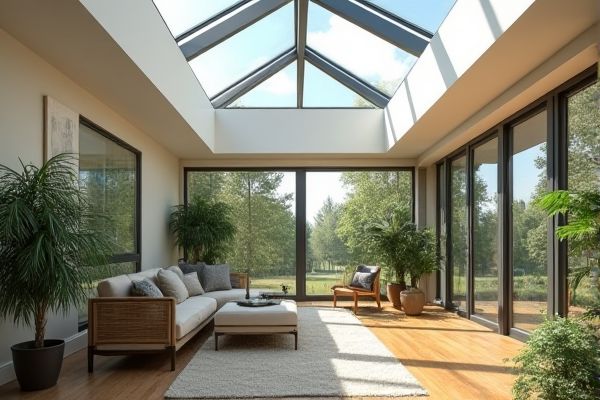
Skylights are installed flush with the roofline to provide natural light without interrupting the roof's shape, while roof windows are operable and extend outward, offering ventilation and panoramic views, especially suitable for sunrooms. Discover how choosing between a skylight and roof window can enhance your sunroom's functionality and aesthetic in the full article.
Table of Comparison
| Feature | Skylight | Roof Window (Sunroom) |
|---|---|---|
| Definition | Fixed or operable window installed on the roof for natural light and ventilation. | Operable roof window designed for roof spaces, often larger, creating sunroom effects. |
| Installation Location | Flat or pitched roofs. | Pitched roofs, integrated into living spaces like sunrooms or lofts. |
| Ventilation | Available in fixed or vented versions; limited airflow. | Operable with better ventilation control. |
| Size & Light | Typically smaller, mainly for light admission. | Larger, designed to maximize sunlight and usability. |
| Usage | Commonly for natural lighting and passive ventilation. | Used to create bright, airy living areas like sunrooms or attics. |
| Cost | Generally lower cost, simpler installation. | Higher cost, complex installation with structural modifications. |
| Energy Efficiency | High-performance glazing available for insulation. | Enhanced insulation due to larger glazing and framing. |
| Maintenance | Lower maintenance, easier to clean. | Requires more upkeep due to size and operable parts. |
Introduction: Skylight vs Roof Window in Sunrooms
Skylights and roof windows both enhance natural light and ventilation in sunrooms, but skylights are fixed and designed primarily for daylight, while roof windows can open for airflow and emergency escape. Skylights typically offer a sleek, flush design integrated into the roof, whereas roof windows are more versatile, providing operability and sometimes egress. Your choice depends on whether you prioritize lighting or ventilation in your sunroom space.
Understanding Skylights: Features and Functions
Skylights are specially designed windows installed in roofs to allow natural light into interior spaces while providing ventilation options and energy efficiency benefits. Unlike roof windows, skylights typically remain fixed or have limited opening capabilities, emphasizing enhanced insulation and weather resistance. Understanding these features helps you choose a daylight solution that maximizes brightness, reduces heating costs, and seamlessly integrates with your sunroom's architectural design.
What Is a Roof Window? Key Characteristics
A roof window is a type of window installed flush with the slope of a roof, designed to bring natural light and ventilation into attic spaces or sunrooms. Key characteristics include operability for easy opening and closing, weatherproof seals to prevent leaks, and strategic placement to maximize daylight while maintaining energy efficiency. Your choice of roof window can enhance the usability and ambiance of a sunroom by creating a bright, airy atmosphere.
Design Differences Between Skylights and Roof Windows
Skylights are fixed glass panels primarily designed to flood interior spaces with natural light without any operable function, while roof windows are hinged or sliding units that can be opened for ventilation. Skylights typically sit flush with the roofline, offering a minimalist aesthetic, whereas roof windows often protrude outward, creating additional headroom and increasing the usable interior space of sunrooms. The design choice between skylights and roof windows significantly affects both the natural light quality and airflow in architectural projects, influencing comfort and energy efficiency.
Installation Processes: Skylight vs Roof Window
Skylight installation typically involves cutting a hole directly into the roof decking and integrating a waterproof flashing system to prevent leaks, often requiring professional expertise. Roof windows, designed to open and provide ventilation, demand precise framing and hinge attachment, which can be more complex than fixed skylights due to their operable features. Understanding these differences ensures your sunroom's lighting and ventilation needs are effectively met with proper structural integration.
Natural Light and Ventilation Performance
Skylights provide superior natural light by maximizing sunlight exposure through horizontal installation on the roof, allowing more direct sunlight to enter interior spaces compared to roof windows typically installed on sloped walls. Roof windows in sunrooms enhance ventilation performance by offering operable features that facilitate airflow regulation and improved indoor air quality. Opting for skylights delivers consistent daylighting benefits, while roof windows combine natural light with effective ventilation tailored to sunroom environments.
Energy Efficiency: Comparing Skylights and Roof Windows
Skylights typically offer better energy efficiency due to their fixed, well-sealed design that minimizes air leakage and heat transfer, often incorporating double or triple glazing for enhanced insulation. Roof windows, which can open for ventilation, may experience slightly higher heat loss or gain but provide improved air circulation that can reduce cooling costs during warmer months. Choosing energy-efficient glazing and proper installation for both options is crucial to maximize insulation values and reduce overall energy consumption in sunroom environments.
Cost Considerations and Maintenance Needs
Skylights generally have lower upfront costs than roof windows in sunrooms but may require more frequent sealing and condensation management to prevent leaks. Roof windows offer better ventilation and natural light control, which can reduce long-term energy costs despite their higher initial installation expenses. Maintenance for roof windows often involves cleaning exterior glass and ensuring proper operation of opening mechanisms, while skylights primarily need inspection for cracks and resealing to maintain weatherproofing.
Aesthetic Impact on Sunrooms
Skylights in sunrooms create a sleek, modern aesthetic by seamlessly integrating into the roof, allowing abundant natural light without obstructing views. Roof windows, with their operable design, add architectural interest while enhancing ventilation and visual connection to the outdoors. Both options elevate the sunroom's ambiance, but skylights emphasize minimalism, whereas roof windows introduce dynamic elements to the overall design.
How to Choose: Skylight or Roof Window for Your Sunroom
When deciding between a skylight and a roof window for your sunroom, consider factors such as ventilation, natural light, and ease of access. Skylights offer fixed, energy-efficient daylight but limited airflow, while roof windows can be opened to improve ventilation and allow for emergency exits. Your choice should align with your sunroom's design goals, whether prioritizing daylight intensity or fresh air circulation.
 homyna.com
homyna.com